Abstract
The need for reducing gun violence is discussed along with the necessity for citizens to assume some responsibility for protecting themselves, their families, and their property from criminal elements because the police cannot physically be everywhere to protect us all of the time. The problem of sensationalization of gun crimes by the media, multiple shootings by deranged individuals, accidents with firearms, suicide rates, and children with guns are discussed.
The relationship of civilian disarmament in the context of tyrannical governments and genocide are also explored. Incidents in which liberty has been extinguished because firearms have been banned and citizens have been disarmed by increasingly oppressive governments, and the converse, countries where freedom has been preserved by armed citizens are also described. We conclude that guns in the hands of law-abiding citizens deter crimes, and nations that trust their citizens with firearms have governments that sustain liberty and affirm individual freedom. Governments that do not trust their citizens with firearms tend to be despotic and tyrannical, and are a potential danger to good citizens — and a peril to humanity.
Keywords: Civilian disarmament, firearms, genocide, gun control, multiple shootings, tyrannical governments
In his celebrated book, The Samurai, the Mountie, and the Cowboy, author and gun rights attorney, David Kopel, makes the point that disparate countries such as Japan and Switzerland have low crime rates, regardless of gun control laws, because of close ties engendered in the traditional family. In those countries, parents spend time with their properly reared children, who are then imbued with a sense of civility as well as civic duty[29] In this milieu, children can be brought up with firearms, instructed in their use and safety, and when they grow up, they should be allowed not only to own guns, but to carry concealed weapons for self and family protection.[18] However, convicted felons and mentally unstable people forfeit this right by virtue of the fact they are a potential danger to their fellow citizens. This has been recently demonstrated by the tragedies that took place in Arizona[6] and in Aurora, Colorado;[20] not only in the United States, but also in Oslo, Norway.[2] These three specific cases represent overt failures in the criminal justice or the mental health system, rather than a problem with “too many guns” in the hands of law-abiding citizens. The case in Arizona is particularly revealing because that deranged individual should have received mental health treatment, which was not administered.[6]
GUN VIOLENCE, STREET CRIME, AND SELF-DEFENSE
Dr. Mark Rosenberg, a former American public health official, once stated, “Most of the perpetrators of violence are not criminals by trade or profession. Indeed, in the area of domestic violence, most of the perpetrators are never accused of any crime. The victims and perpetrators are ourselves — ordinary citizens, students, professionals, and even public health workers.”[26] That erroneous statement is contradicted by available data, U.S. government data.
According to the United States Department of Justice, the typical murderer has had a prior criminal history of at least six years, with four felony arrests in his record, before he finally commits murder.[4] Federal Bureau of Investigation (FBI) statistics reveal that 75% of all violent crimes for any locality are committed by 6% of hardened criminals and repeat offenders.[17] Less than 2% of crimes committed with firearms are carried out by licensed (e.g. concealed carry permit holders), law-abiding citizens.[7,27,31]
Much has been said about “crimes of passion” that supposedly take place impulsively, in the heat of the night or in the furor of a domestic squabble. Criminologists have pointed out that homicides in this setting are the culmination of a long simmering cycle of violence. In one study of police records in Detroit and Kansas City, it was revealed that in “90% of domestic homicides, the police had responded at least once before, during the prior two years, to a disturbance,” and in over 50% of the cases, the police had been called five or more times to that dysfunctional domicile.[45]
These are not crimes of passion consummated impulsively in the heat of the night by ordinary citizens, but the result of violence in highly dysfunctional families, in the setting of alcohol abuse, illicit drug use, or other criminal activities. Violent crimes continue to be a problem in the inner cities of the large metropolitan areas, with gangs involved in robberies, drug trade, juvenile delinquency, and even murder. Yet crimes in rural areas, despite the preponderance of guns in this setting, remain low.[7,17,19,27,28,39]
Gun availability to law-abiding citizens does not cause crime. However, a permissive criminal justice system, with revolving prison doors in the context of gun prohibition, exacerbates the problem of crime by making it more difficult for law-abiding citizens to defend themselves, their families, and their property. In fact, there was a modest increase in both homicide and suicide rates in the United States after prohibition in the 1920s and again following the passage of the Gun Control Act of 1968 [Figure 1]. Those trends have fortunately subsided.[18,19,27,28]
Figure 1.
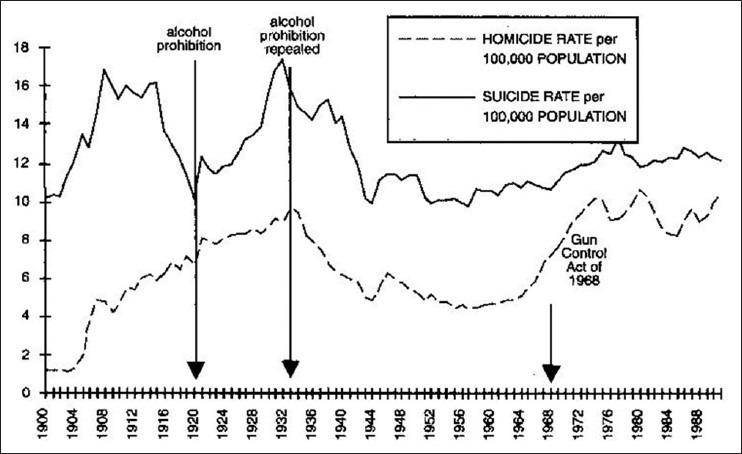
Twentieth century United States homicide and suicide rates wax and wane over time, but at times of government prohibitions, both rates visibly increase, only to decrease over time as restrictions are eased
As to how citizens can protect themselves from criminal assailants when the police, more often than not, are not there to protect them, the National Victims Data suggests that, “while victims resisting with knives, clubs, or bare hands are about twice as likely to be injured as those who submit, victims who resist with a gun are only half as likely to be injured as those who put up no defense.” Of particular interest to women and self-defense, “among those victims using handguns in self-defense, 66% were successful in warding off the attack and keeping their property. Among those victims using non-gun weapons, only 40% were successful.”[27] The gun is a great equalizer for law-abiding citizens in self and family protection, particularly women, when they are accosted in the street or when they are defending themselves and their children at home.[7,27,28,32,40,43]
MULTIPLE SHOOTING TRAGEDIES
Although not all citizens would want to carry a concealed firearm for self-protection, criminologists point out that criminals do make quick “risk-versus-benefit” assessments about that looming, potential threat. Thus, criminological studies consistently reveal that just the knowledge that one in five or six citizens in a public place could very well be armed can deter crimes and could very well avert massacres, as has been the case in Israel, after the infamous Maalot Massacre,[8] Switzerland,[21] and the United States.[9,27–29,31] In Switzerland, for example, where gun laws are notoriously liberalized, there was not a single report of armed robbery in Geneva in 1993![21]
Now, let us consider the recent case in Norway. After bombing a government building in Oslo and then taking over Utoya, an island in a nearby lake, a homicidal killer perpetrated a horrible massacre.[2] He is a declared anti-Islamic fanatic, but instead of Moslems in a foreign land, Anders Behring Breivik massacred 69 of his fellow countrymen. Breivik systematically hunted down unarmed people at a youth camp located on that island, methodically killing mostly teenagers who could not defend themselves. Imagine if just one adult had carried a gun, knew how to use it, and was prepared to defend his / her life and the lives of others.
Yes, there still may have been a massacre, but not 69 people shot haplessly in a virtual dove shoot. Just one individual armed and willing to protect his / her life and the lives of others was all that was needed to stop the carnage. Furthermore, even if the intended victim was prosecuted later for killing the madman in self-defense and for standing his / her ground, it would have limited the massacre and saved the lives of others. This is true not only for Norway, but for any country, even a European country with draconian gun control laws.
However, in most European countries guns have long been registered, or banned and confiscated. Citizens are disarmed in the course of “progress,” and in those countries, no one even thinks about self-defense anymore. They depend on the government completely for protection. Where guns are banned only criminals have guns.[10,11,27–29,31]
In Macon, Georgia, USA, we recently had the case of a business woman (also a grandmother), who was attacked by two thugs bent on robbing her and perhaps even raping and killing her. They followed the woman home at 1:30 a.m. as she left one of her convenience store businesses. The thugs pulled guns on her and demanded cash as she sat in her car. However, the grandmother was armed. Shots were exchanged. The woman wounded one of her assailants, who was later apprehended as he rushed to a local hospital. The other criminal also fired shots at her, but escaped. She is safe and sound. “I carry a gun all the time,” she told a local newspaper reporter![35]
Of course in the southern United States this grandmother is a heroine and no one would consider prosecuting her.[25] But that is not the usual course of events in other countries, particularly in Great Britain. In England, a farmer who defended his home and possibly his life was sentenced to life in prison for shooting a burglar, a dangerous criminal![11]
MEDIA COVERAGE — SENSATIONALISM OR PROPAGANDA
The way the subject of guns and violence is reported by the popular media brings us to another problem. Many reports are saturated with media bias and sensationalism. The mainstream American press, just like their Western European counterparts, is overtly for gun control and look askance at citizens possessing firearms for self and family protection. With that in mind, let us take a look at how the media reports mass shootings in America. Four illustrative cases will help us draw inferences as to the nature of these incidents in the United States and the associated media coverage.
In 1997, in Pearl, Mississippi, 16-year-old Luke Woodham used a hunting rifle to kill his ex-girlfriend and her close friend and wound seven other students. Assistant Principal Joel Myrick retrieved his handgun from his automobile and halted Woodham's shooting spree. Myrick held the young delinquent at bay until the police arrived. Later it was discovered that Woodham had also used a knife to stab his mother to death earlier that morning. Even though this shooting incident was widely reported, the fact that Mr. Myrick, an armed citizen, had prevented a larger massacre by retrieving and using his handgun was ignored by the media.
Then in 1998, in Edinboro, Pennsylvania, a deadly scenario took place when 14-year-old Andrew Wurst killed one teacher and wounded another teacher as well as two fellow classmates. The shooting rampage in Edinboro was halted by local merchant James Strand, who used his shotgun to force the young criminal to halt his firing, drop his gun, and surrender to the police.
And in another unreported incident in Santa Clara, California, Richard Gable Stevens rented a rifle for target practice at the National Shooting Club on July 5, 1999, and then began a shooting rampage, herding three store employees into a nearby alley, and stating he intended to kill them. When Stevens became momentarily distracted, a shooting club employee, who had a .45 caliber handgun concealed under his shirt, drew his weapon and fired. Stevens was hit in the chest and critically wounded. He was held at bay until the police arrived. A massacre in the making was prevented. The armed employee, an unsung hero, was ignored by the major media. Why are these and other similar incidents, where the tables are turned, and citizens use guns to protect themselves and others, only seldom reported by the mainstream media?[7–9]
Finally, the more recent shooting in Aurora, Colorado, on July 19, 2012, resulted in the death of a dozen people because a deranged individual with criminal intent, James Holmes, was able to enter a theater with a posted “gun-free zone” sign, a designated public place where armed law-abiding citizens are not allowed to carry their concealed firearms. This theater had a “no guns policy,” similar to the situation in Norway, which amounts to a potential dove shoot, where only the predator, a hunter of humans, is armed. Interestingly, the United States media did not report another shooting incident that took place three months earlier in, of all places, Aurora, Colorado, where a law-abiding citizen, an armed church-goer, shot another human predator and stopped a shooting rampage, saving his life and that of others in the process.[20,33]
As we have described in Part I of this essay —thanks to the study of Dr. Edgar A. Suter, former Chairman of Doctors for Integrity in Research and Public Policy, and others, whose studies we have cited — we now know that in the United States the defensive use of firearms by law-abiding citizens surpasses the illegal use of guns by criminals:
The defensive use of firearms by citizens amounts to 2.5 million uses per year and dwarfs the offensive gun use by criminals. In the United States, between 25 and 75 lives are saved by a gun in self and family protection for every life lost to a gun in crime. Medical costs saved by guns in the hands of law-abiding citizens are 15 times greater than costs incurred by the criminal use of firearms. Guns also prevent injuries to good people and protect billions of dollars of property every year.
Unfortunately, the American media does not give those defensive uses of firearms the attention they deserve, and they go unreported. By and large, to read about the cases where law-abiding citizens use firearms for self and family protection, one has to read independently published books such as Robert A. Waters’ excellent tome, The Best Defense.[43] Rarely do these cases get publicized in the mass media nor are they compiled, studied, and published in the medical journals, as public health investigators do with their “gun and violence” research.[7,13,27,31,40,43]
SUICIDE, ACCIDENTAL SHOOTINGS, CHILDREN AND GUNS
Several gun researchers have written about suicides and have linked these fatalities to the availability of guns.[38] Medical critics, however, cite the overwhelming evidence compiled from the psychiatric literature that untreated or poorly managed depression is the real culprit behind the relatively high rates of suicide in the United States and other countries. Moreover, countries such as Japan and Hungary, and those in Scandinavia — all of whom boast of draconian gun control laws and low rates of firearm availability — have much higher rates of suicide (two-to-three times higher) than the United States.[7,26,29] In those countries, citizens simply use other cultural or universally available methods, such as Seppuku (Hara-kiri) in Japan, drowning in the Danube as in Hungary, suffocation by poisonous gases from stoves or automobile exhausts, or hanging and strangulation, as in Denmark and Germany, or even drinking agricultural pesticides, as is commonly done in Sri Lanka. Moreover, in these countries, citizens commit suicide quite effectively by these methods at higher rates than in the United States [Figure 2].
Figure 2.
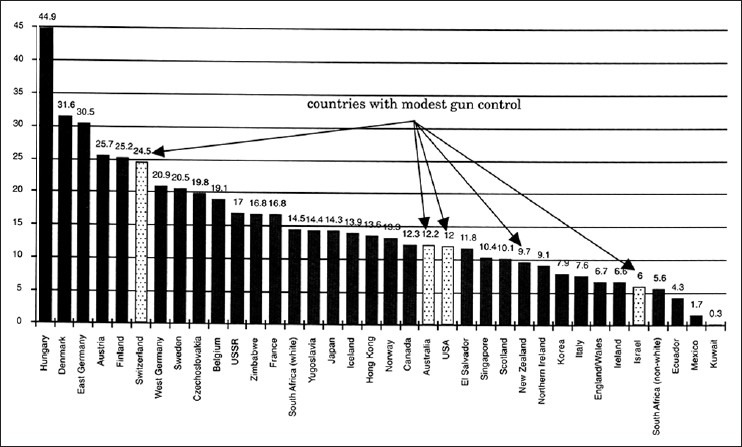
International suicide rate comparison in different countries (World Health Organization, 1989)
A child's death from any cause is a tragedy. In the United States in the year 2000, 600 children and adolescents died of accidental gunshot wounds, 2,700 perished in motor vehicle accidents, 3,600 children died from burns, 3,900 died from drowning, and 12,100 died from poisoning. These are all tragedies, but do we want to ban automobiles, matches, swimming pools, and household chemicals? Firearm accident rates in the United States have been declining steadily since the turn of the century, because of the emphasis placed on gun safety and education courses, including the National Rifle Association's Eddie Eagle program, which has touched an excess of 11 million youngsters in the United States[7,30] [Figure 3].
Figure 3.
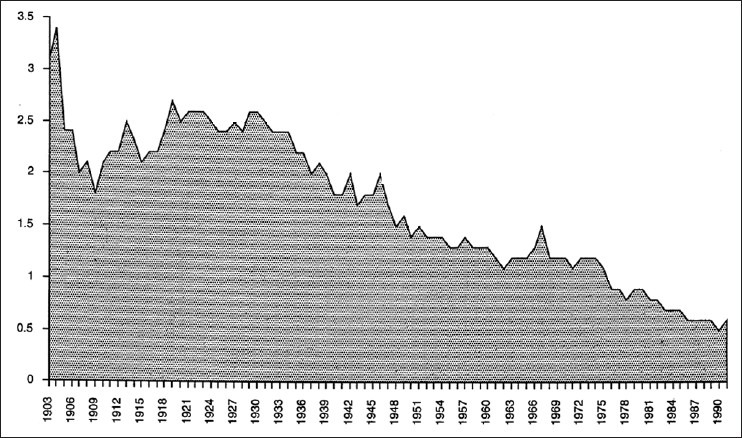
Twentieth century United States firearm accident rates per 100,000 population have been decreasing from 1903 to 1991 because of gun safety awareness (National Safety Council, 1992)
As far as adolescent violence is concerned, more than 20,000 laws are already on the books in the United States, including a sizable number of laws pertaining to the proscription of handgun possession by minors and banning guns on school grounds. Yet, despite all the media's sensationalization of crime, the available FBI statistics for the year 2000 show that, like the not-so-well-known drop in gun accident rates, there has also been a steady decline in homicide rates in every segment of American society. In fact, in the United States, murder and violent crimes have reached 30- and 25-year lows, respectively.[18] The opposite has been the case in Australia and Great Britain.[10,11,32,39]
GUN VIOLENCE AND CIVIL LIBERTIES — AN INTERNATIONAL PERSPECTIVE
Australians learned the lessons of indiscriminate, draconian gun control laws the hard way. In 1996, a criminally insane man shot to death 35 people at a Tasmanian resort. The government immediately responded by passing stringent gun control laws, banning most firearms, and ordering their confiscation. More than 640,000 guns were seized from ordinary Australian citizens.[10]
As a result, there was a sharp and dramatic increase in violent crime against the disarmed law-abiding citizens, who in small communities and particularly in rural areas were now unable to protect themselves from brigands and robbers. That same year in the state of Victoria, for example, there was a 300% increase in homicides committed with firearms. The following year, robberies increased by almost 60% in South Australia. By 1999, assaults had increased by almost 20% in New South Wales. Two years following the gun ban / confiscation, armed robberies had risen by 73%, unarmed robberies by 28%, kidnappings by 38%, assaults by 17%, and manslaughter by 29%, according to the Australian Bureau of Statistics.[41]
Interestingly, the same phenomenon occurred in Great Britain. Following a 1996 massacre of school children by a madman in Dunblane, Scotland, the British government banned and ordered the confiscation of most firearms. Since then, a horrific crime wave has taken place in England and Scotland. In 1998, the United States Department of Justice declared that the rate of muggings in England had surpassed those in the United States by 40%, while assault and burglary rates were nearly 100% higher in England than in the United States. To make matters worse for England — and this is also true for Canada — in those countries where citizens are disarmed in their homes, day burglary is commonplace and dangerous because criminals know they will not be shot at if caught in flagrante delicto. The criminals have nothing to fear from disarmed and helpless homeowners. Not so in the United States, where burglars not only prefer night burglaries, but they try to make sure homeowners are not at home to avoid being shot at by the intended victim.[10,29,32]
The Sunday Times of London, on January 11, 1998, wrote, the rising tide of thievery and burglaries in England dubbed Britain “a nation of thieves”. The same article further noted, “More than one in three British men has a criminal record by the age of 40. While America has cut its crime rate dramatically Britain remains the crime capital of the West. Where have we gone wrong?”[11]
It does not have to be this way. A study performed by the United States Department of Justice, Office of Juvenile Justice and Delinquency Prevention tracked 4,000 juveniles aged 6 – 15 years, in Denver (CO), Pittsburgh (PA), and Rochester (NY) from 1993 to 1995. The investigators found that children who were taught to use firearms with parental supervision, as in hunting or target shooting, were 14% less likely to commit acts of violence and street crimes than children who had no guns in their homes (24%); whereas, children who obtained guns illegally, did so at the whopping rate of 74%.[42] This study also provided more evidence that in close nuclear families, where children were close to their parents, youngsters could be taught to use guns responsibly. These youngsters, in fact, grew up to be more responsible in their conduct and more civil in their behavior [Figure 4].
Figure 4.
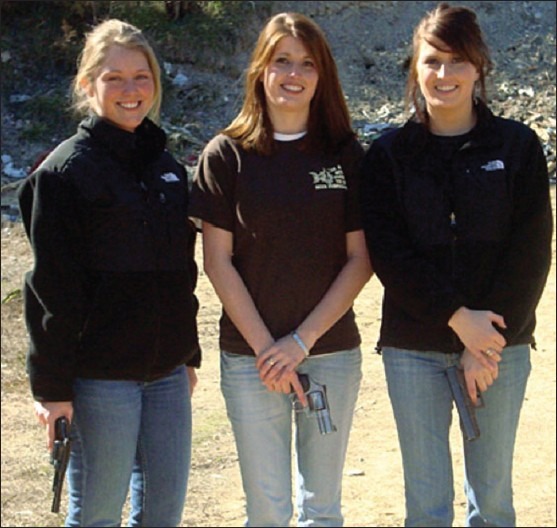
Young American women practicing the use of firearms (Courtesy Delta Wildlife, 2009)
CIVILIAN DISARMAMENT, TYRANNY, AND GENOCIDE
Depending on the level of culture and social progress, violence can take different forms in different societies.[39] For example, in the mid-twentieth century, the communist government of dictator Joseph Stalin killed more Soviet citizens through privation, forced labor, and famine than soldiers who succumbed while fighting the Germans in World War II on the battlefields of Russia.[36]
More recently, in 1994, the Hutu-led Rwandan government massacred between 800,000 and 1.1 million people, mostly Tutsis, in a genocide carried out largely with machete-wielding government forces. The massacres took place despite the presence nearby of the United Nation “peace-keeping” forces, armed with automatic weapons, who failed to intervene. The Tutsis were not only surprised, but also unarmed and helpless.
Civilian disarmament has always preceded genocide in authoritarian and totalitarian states. In the gruesome, but monumental book, Lethal Laws, we learn that repressive governments that conducted genocide and mass killings of their own populations have first always disarmed their citizens.[37] The political formula for accomplishing this goal, hallmarks of tyrannical governments, is and remains: public propaganda against firearms, followed step-by-step by gun registration, banning, confiscation, and finally total civilian disarmament. Enslavement of the people then follows easily with limited resistance.[12] This is what happened in Nazi Germany, the Soviet Union, Red China, Cuba, and other totalitarian regimes of the twentieth century. In Part I, I presented the reader with short introductory vignettes about the ghastly incidents in Poland, Hungary, and Cuba, as they relate to civilian disarmament in both war and peacetime.
When presented with these deadly chronicles and perilous historic sequences, the popular opinion is “it cannot happen here”. As to the dangers of licensing of gun owners and registration of firearms, the same uninformed respondents frequently retort: “If you don’t have anything to hide, then you don’t have anything to fear!” Followed by, “I see nothing wrong with gun registration and some restrictions on gun ownership, because we have to do something; there are just too many guns out there that fall into the wrong hands.” These naïve attitudes ignore the penchant of governments to accrue power at the expense of the liberties of individuals.[9,15,29,32]
Civilian disarmament is not only harmful to one's freedom and potentially deadly to one's existence, but also counterproductive in achieving safety. This has been further attested by University of Hawaii Professor, R. J. Rummel, in his book, Death by Government (1994), and by the French scholar Stιphane Courtois and his associates in their monumental volume, The Black Book of Communism (1999). These books make it clear that authoritarian governments that limit their citizens’ freedom and proscribe them from owning guns are always dangerous to liberty — and the health of humanity. During the twentieth century, more than 100 million people have been exterminated by their own repressive governments — police states bent on destroying liberty and building communism, socialism, collectivism, and other utopias that turn out to be hells on earth![5,15,16,36,37]
ARMED PEOPLE AND THE PRESERVATION OF FREEDOM
In debunking the myth that “guns increase violent crime,” Richard Poe, the former editor of FrontPage Magazine, has rebutted the false assumption that America is more violent than other nations, again emphasizing that more people during the twentieth century were killed in other countries by their own governments than by war, while reaffirming that gun control laws have almost always preceded genocide or mass murder of the people (democide) by their own governments.[32,36,37]
While the United States and Switzerland have more guns per capita than any of the other developed countries, they also have more freedom in general than countries with draconian gun control laws. Even Japan, a country that has embraced democracy and Western mores in many ways, still has the centuries-old tradition of subordination of individualism to the state, and the collective Japanese citizens have less individual freedom than those of Switzerland, where virtually every citizen is armed and individual freedom is paramount [Figure 5].
Figure 5.
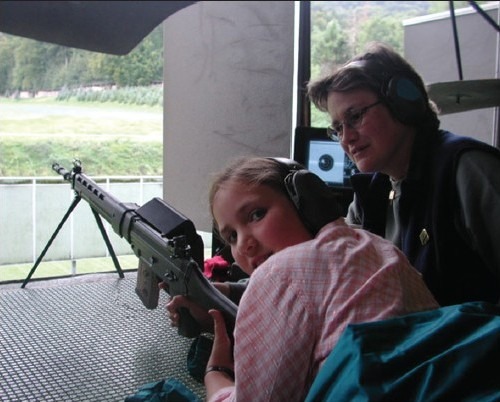
Teenage Rifle Festival in Switzerland, where Swiss teens are instructed in the use of firearms, including assault rifles (Courtesy Stephen Halbrook, 2004)
Japan may have a low crime rate, but citizens live in a virtual authoritarian state, where the police keep full dossiers on every citizen, and “twice a year, each Japanese homeowner gets a visit from the local police to update files” on every aspect of the citizen's home life.[29,32]
Switzerland, on the other hand, a small, landlocked country, stood up against the Nazi threat during World War II, because each and every male was an armed and free citizen. (The Swiss republic was the “Sister-Republick” that the American Founding Fathers so greatly admired.) Nazi Germany could have overwhelmed Switzerland during World War II, but the price was too steep for the German High Command. Instead, the Nazi juggernaut trampled over Belgium, Luxembourg, Holland, Norway, and other countries, and avoided the armed Swiss nation, the “porcupine,” which was prepared for war and its military was ready to die rather than surrender.[22,32]
As to what an armed population, such as those of the original 13 American colonies that later became the United States, did to obtain their independence is a well-known story. Suffice to say, that the shot heard “around the world” on Patriot's Day (April 19, 1775) was precipitated when the British attempted to seize the arm depots and disarm the American militia at Lexington and Concord in the Colony of Massachusetts.[23,24] As to what an armed population can do to prevent the overthrow of their government by oppressive, communist movements, I recommend Larry Pratt's excellent little tome, Armed People Victorious (1990). Armed People Victorious vividly recounts stories of how two countries, as dissimilar as Guatemala and the Philippines, teetering on the brink of disaster, turned defeat into victory, when the governments recognized that allowing and encouraging the people to form armed militias to protect themselves, their families, and their villages from communist insurgents in the 1980s, helped to preserve their freedom.[34] [Figure 6]
Figure 6.
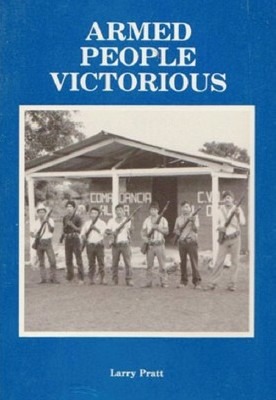
Armed People Victorious book cover (Courtesy Larry Pratt, 1990)
Why is this so important to us as physicians? First, because we are all citizens, and we have been educated enough to understand the importance of preserving or attaining freedom. Second, because as neurosurgeons we can be compassionate and still be honest and have the moral courage to pursue the truth and find effective solutions through the use of sound, scholarly research, and factual information. The social problem of guns and violence should be no different.[3,13,14] We have an obligation to reach our conclusions based on objective data, historical experience, and scientific information, rather than ideology, emotionalism, expediency, or partisan politics. Moreover, the lessons of history sagaciously reveal that whenever and wherever science and medicine have been subordinated to the state, and individual freedom has been crushed by tyranny, the results for medicine have been as perverse as they have been disastrous, as the barbarity of Nazi doctors and Soviet and Cuban psychiatrists amply testified. Beyond the abolition of freedom and dignity, the perversion of science and medicine becomes the vehicle for the imposition of slavery and totalitarianism.[1,5,15,16,37,44] Governments that trust their citizens with guns are governments that sustain and affirm individual freedom. Governments that do not trust their citizens with firearms tend to be despotic and tyrannical. Let us conclude Part II, the final chapter of this essay, with the wise words of another American statesman, this time Thomas Jefferson (1743 – 1826), the author of the Declaration of Independence and the third President of the United States of America, who warned us, “When the government fears the people there is liberty. When the people fear the government there is tyranny.”
Footnotes
Available FREE in open access from: http://www.surgicalneurologyint.com/text.asp?2012/3/1/135/103542
REFERENCES
- 1.Alexander L. N Engl J Med. Flushing, New York: Reprinted by Bibliographic Press; 1949. Jul 14, [Last accessed on 1998 May 1]. Medical science under dictatorship. 1996. Available from: http://www.haciendapub.com/medicalsentinel/euthanasia-medical-science-and-road-genocide . [DOI] [PubMed] [Google Scholar]
- 2.BBC. Prosecutors in Norway call for Breivik insanity verdict. [Last accessed on 2012 June 21]. Available from: http://www.bbc.co.uk/news/world-europe-18530670 .
- 3.Bennett JT, DiLorenzo TJ. From Pathology to Politics: Public Health in America. New Brunswick, NJ: Transaction Publishers; 2000. [Google Scholar]
- 4.Guns and crime. Washington DC: U.S. Government Printing Office; 1994. Bureau of Justice Statistics, U.S. Department of Justice; p. NCJ-147003. [Google Scholar]
- 5.Courtois S, Werth N, Panne JL, et al. The Black Book of Communism — Crimes, Terror, Repression. Cambridge, MA: Harvard University Press; 1999. [Google Scholar]
- 6.Faria MA., Jr The tragedy in Arizona — A mental health challenge failure. [Last accessed on 2011 Jan 12]. GOPUSA.com. Available from: http://www.haciendapublishing.com/articles/faria-tragedy-arizona-mental-health-challenge-failure .
- 7.Faria MA., Jr Public health and gun control — A review (Part I): The benefits of firearms. [Last accessed on 2001 April 12];Medical Sentinel. 2001 6:14–18. Available from: http://www.haciendapubl i shing.com/articles/public-health-and-gun-control-review-part-i-benefits-firearms . [Google Scholar]
- 8.Faria MA., Jr Public health and gun control — no deterrent to crime. [Last accessed on 1999 Nov 22];The New American. 1999 Nov 22;15(24):23–24. Available from: http://www.haciendapub.com/articles/public-health-and-gun-control-no-deterrent-crime . [Google Scholar]
- 9.Faria MA., Jr Public health and gun control — A review (Part II): Gun violence and constitutional issues. [Last accessed on 2001 April 19];Medical Sentinel. 2001 6:11–13. Available from: http://www. haciendapublishing.com/medicalsentinel/public-health-and-guncontrol-review-part-ii-gun-violence-and-constitutional-issues . [Google Scholar]
- 10.Faria MA., Jr Gun control in Australia — chaos down under. Medical Sentinel. 2000;5:107. [Google Scholar]
- 11.Faria MA., Jr A Nation of Thieves? WorldNetDaily. 2003. Oct 17, [Last accessed on 2003 October 17]. Available from: http://www.wnd.com/index.php?fa=PAGE.view&pageId=21323 .
- 12.Faria MA., Jr National gun registration — Paving the road to tyranny. NewsMax.com. 2001. Aug 31, [Last accessed on 2001 Aug 31]. Available from: http://www.haciendapub.com/articles/gun-control-and-hallmarks-tyranny-%E2%80%94-reappraisal .
- 13.Faria MA., Jr The perversion of science and medicine (Part I): On the nature of science; (Part III): Public health and gun control research; (Part IV): The battle continues. Medical Sentinel. 1997;2:46–53. and Medical Sentinel 1997;2:81-86. [Google Scholar]
- 14.Faria MA., Jr Public health — from science to politics. [Last accessed on 2001 June 1];Medical Sentinel. 2001 6:46–49. 7. Available from: http://www.haciendapub.com/medicalsentinel/public-health-science-politics . [Google Scholar]
- 15.Faria MA., Jr The perversion of science and medicine (Part II): Soviet science and gun control. [Last accessed on 1997 April 1];Medical Sentinel. 1997 2:49–53. Available from: http://www.haciendapub.com/medicalsentinel/perversion-science-and-medicine-part-ii-soviet-science-and-gun-control . [Google Scholar]
- 16.Faria MA. Cuban psychiatry — The perversion of medicine. [Last accessed on 2000 September 1];Medical Sentinel. 2000 5:160–162. Available from: http://www.haciendapub.com/medicalsentinel/cuban-psychiatry-perversion-medicine . [Google Scholar]
- 17.Federal Bureau of Investigation, U.S. Department of Justice. Uniform crime reports: Crime in the United States 1992. Washington DC: U.S. Government Printing Office; 1993. [Google Scholar]
- 18.Gearan, Anne Violent crime hits 25-year low. Associated Press, December 28, 1998. Sniffen, Michael J. Murder rate reaches 30-year low. Associated Press, November 23, 1998. Serious crimes drops in early 1998. Associated Press, December 14, 1998. Juvenile Justice and Delinquency Prevention: FBI website, December 14, 1998.
- 19.Grove RD, Hetzel AM. Vital Statistics Rates in the United States 1900-1960. Washington DC: National Center for Health Statistics; 1968. 20th Century U.S. Homicide and Suicide Rates per 100,000 population. and Vital Statistics of the United States. Hyattsville MD: National Center for Health Statistics. Individual volumes for 1961 through 1991. [Google Scholar]
- 20.Gun Owners of America (GOA). Help Gun Owners of America stop the UN's continuous attempts to destroy the 2nd Amendment. [Last accessed on 2012 July 31]. Available from: http://gunowners.org/a07312012.htm .
- 21.Halbrook SP. Wall Street Journal. Europe edition 1999. Jun 4, Armed to the teeth and free. [Google Scholar]
- 22.Halbrook SP. Target Switzerland — Swiss Armed Neutrality in World Wart II. Boston: Da Capo Press; 1998. [Google Scholar]
- 23.Halbrook SP. That Every Man Be Armed — The Evolution of a Constitutional Right. Albuquerque, NM: University of New Mexico Press; 1984. [Google Scholar]
- 24.Hardy DT. Origins and Development of the Second Amendment. Chino Valley, AZ: Blacksmith Corporation; 1986. [Google Scholar]
- 25.Kantor M. A Cuban Southerner's Defense of the South: An Interview with Dr. Miguel A. Faria Jr. [Last accessed on 2003 January 4]. Available from: http://www.lewrockwell.com/kantor/kantor77.html .
- 26.Kates DB, Schaffer HE, Lattimer JK, Murray GB, Cassem EH. Guns and public health: Epidemic of violence or pandemic of propaganda? Tennessee Law Review. 1995;62:513–596. [Google Scholar]
- 27.Kleck G. Point Blank — Guns and Violence in America. Hawthorne, NY: Aldine de Gruyter; 1991. [Google Scholar]
- 28.Kleck G. Targeting Guns — Firearms and Their Control. Hawthorne, NY: Aldine de Gruyter; 1997. [Google Scholar]
- 29.Kopel DB. The Samurai, the Mountie, and the Cowboy: Should America Adopt the Gun Controls of Other Democracies? Buffalo, New York, NY: Prometheus Books; 1992. [Google Scholar]
- 30.Kopel DB. Children and Guns in Guns: Who Should Have Them. New York, NY: Prometheus Books; 1995. pp. 309–443. [Google Scholar]
- 31.Lott JR., Jr . More Guns, Less Crime — Understanding Crime and Gun Control Laws. Chicago, IL: University of Chicago Press; 1998. [Google Scholar]
- 32.Poe R. The Seven Myths of Gun Control — The Truth about Guns, Crime, and the Second Amendment. Roseville, California: Prima Publishing; 2001. [Last accessed on 2002 July 10]. Available from: http://archive.newsmax.com/archives/articles/2002/7/9/150556.shtml . [Google Scholar]
- 33.Pratt E. Colorado shooting shows the failure of gun control laws. U.S. News and World Report. [Last accessed on 2012 July 26]. Available from: http://www.usnews.com/topics/author/erich_pratt .
- 34.Pratt L. Armed People Victorious. Springfield, Virginia: Gun Owners Foundation; 1990. [Google Scholar]
- 35.Ramati P. ‘I carry a gun all the time’ says woman who thwarted Macon holdup attempt. Macon Telegraph. [Last accessed on 2012 April 23]. Available from: http://www.macon.com/2012/04/23/2000577/i-carry-a-gun-all-the-time-says-html#storylink=misearch .
- 36.Rummel RJ. Death by Government. Piscataway, NJ: Transaction Publishers; 1994. [Google Scholar]
- 37.Simkin J, Zelman A, Rice A. Lethal Laws. Milwaukee, WI, Jews for the Preservation of Firearm Ownership. 1994. Available from: http://www.jpfo.org .
- 38.Sloan JH, Rivara FP, Reay DT, Ferris JA, Kellermann AL. Firearm regulations and rates of suicide: A comparison of two metropolitan areas. N Engl J Med. 1990;322:369–73. doi: 10.1056/NEJM199002083220605. [DOI] [PubMed] [Google Scholar]
- 39.Stolinsky DC. America the most violent nation? Med Sentinel. 2000;5:199–201. [Google Scholar]
- 40.Suter E, Waters WC, Murray GB, Hopkins CB, Asiaf J, Moore JB, et al. Violence in America — effective solutions. J Med AssocGa. 1995;84:253–64. [PubMed] [Google Scholar]
- 41.These statistics are no longer posted and Australian officials have recently denied posting these data, even though they were documented at the time by the NRA and other sources. See also Schneider J. Australia's Lesson for US Gunowners. Gun News Digest. 1996;2:24–25. 28-31; Coochey J. Under Handed Statistics from ‘Down Under.’ Gun News Digest 1999;4:42-3; and Coochey J. Australia’s Anti-Gun Officials Have No Statistics to Wear. Gun News Digest 2000;5:34-6. [Google Scholar]
- 42.U.S. Department of Justice, Office of Juvenile Justice and Delinquency Prevention. “Urban Delinquency and Substance Abuse”. 1999:18. [Google Scholar]
- 43.Waters RA. The Best Defense — True Stories of Intended Victims Who Defended Themselves With a Firearm. Nashville, TN: Cumberland House; 1998. [Google Scholar]
- 44.Weyers W. Death of Medicine in Nazi Germany Philadelphia, PA: Lippincott-Raven Publishers. 1998. [Last accessed on 1999 Mar 1]. Available from: http://www.haciendapub.com/medicalsentinel/death-medicine-nazi-germany-wolfgang-weyers-md .
- 45.Wilt GM, Bannon JD, Breedlove RK. Domestic Violence and the Police: Studies in Detroit and Kansas City. Washington, DC: Police Foundation; 1977. [Google Scholar]


